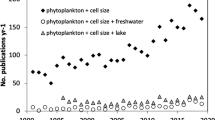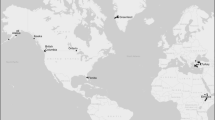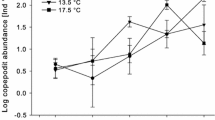Abstract
Ecological consequences of global warming include shifts of species ranges toward higher altitudes and latitudes as well as temporal shifts in phenology and life-cycle events. Evidence is accumulating that increasing temperature is also linked to reduced body size of ectotherms. While temperature can act directly on body size, it may also act indirectly by affecting the timing of life-cycle events and the resulting population age and size structure, especially in seasonal environments. Population structure may, in turn, be influenced by temperature-driven changes in resource availability. In a field mesocosm experiment, we investigated how water temperature and mixed surface layer depth (a temperature-dependent determinant of light availability to phytoplankton) affected population dynamics, population age and size structure, and individual size at stage (size at first reproduction) of Daphnia hyalina during and after a phytoplankton spring bloom. Mixed layer depth was inversely related to the magnitudes of the phytoplankton spring bloom and the subsequent Daphnia peak, but had no effect on the body size of Daphnia. Conversely, temperature had no effects on abundance peaks but strongly affected the timing of these events. This resulted in at times positive, at other times negative, transient effects of temperature on mean body size, caused by asynchronous changes in population size structure in cold versus warm treatments. In contrast to mean body size, individual size at stage consistently decreased with increasing temperature. We suggest that size at stage could be used as an unbiased response parameter to temperature that is unaffected by transient, demographically driven changes in population size structure.



Similar content being viewed by others
References
Arendt J (2007) Ecological correlates of body size in relation to cell size and cell number: patterns in flies, fish, fruits and foliage. Biol Rev 82:241–256
Atkinson D (1994) Temperature and organism size: a biological law for ectotherms? Adv Ecol Res 25:1–58
Berger SA, Diehl S, Kunz TJ, Albrecht D, Oucible AM, Ritzer S (2006) Light supply, plankton biomass and seston stoichiometry in a gradient of lake mixing depths. Limnol Oceanogr 51:1898–1905
Berger SA, Diehl S, Stibor H, Trommer G, Ruhenstroth M (2010) Water temperature and stratification depth independently shift cardinal events during plankton spring succession. Global Change Biol 16:1954–1965
Brambilla DJ (1980) Seasonal changes in size at maturity in small pond Daphnia. In: Kerfoot WC (ed) Evolution and ecology of zooplankton communities. University Press of New England, Hanover, pp 438–455
Brown JH, Gillooly JF, Allen AP, Savage VM, West GB (2004) Toward a metabolic theory of ecology. Ecology 85:1771–1789
Coats R, Perez-Losada J, Schladow G, Richards R, Goldman C (2006) The warming of Lake Tahoe. Clim Change 76:121–148
Culver D (1980) Seasonal variation in the sizes at birth and at first reproduction in Cladocera. In: Kerfoot WC (ed) Evolution and ecology of zooplankton communities. University Press of New England, Hanover, pp 358–366
Daufresne M, Lengfellner K, Sommer U (2009) Global warming benefits the small in aquatic ecosystems. Proc Natl Acad Sci USA 106:12788–12793
DeMott WR (1982) Feeding selectivities and relative ingestion rates of Daphnia and Bosmina. Limnol Oceanogr 27:518–527
DeMott WR, McKinney RN, Tessier AJ (2010) Ontogeny of digestion in Daphnia: implications for the effectiveness of algal defenses. Ecology 91:540–548
Diehl S (2007) Paradoxes of enrichment: effects of increased light vs. nutrient supply on pelagic producer-grazer systems. Am Nat 169:173–191
Diehl S, Berger SA, Ptacnik R, Wild A (2002) Phytoplankton, light, and nutrients in a gradient of mixing depths: field experiments. Ecology 83:399–411
Ebert D (1991) The effect of size at birth, maturation threshold and genetic differences on the life-history of Daphnia magna. Oecologia 86:243–250
Gardner JL, Peters A, Kearney M, Joseph L, Heinson R (2011) Declining body size: a third universal response to warming? Trends Ecol Evol 26:285–291
Gienapp P et al (2008) Climate change and evolution: disentangling environmental and genetic responses. Mol Ecol 17:167–168
Gliwicz ZM (1980) Filtering rates, food size selection and feeding rates in cladocerans: another aspect of interspecific competition in filter feeding zooplankton. Am Soc Limnol Oceanogr Spec Symp 3:282–291
Gliwicz ZM (1986) Predation and the evolution of vertical migration in zooplankton. Nature 320:746–748
Gliwicz ZM (1990) Food thresholds and body size in cladocerans. Nature 343:638–640
Green J (1954) Size and reproduction in Daphnia magna. Proc Zool Soc Lond 124:535–545
Hildrew AG, Raffaelli DG, Edmonds-Brown R (2007) Body size: the structure and function of aquatic ecosystems. Cambridge University Press, UK
Jäger CG, Diehl S, Matauschek C, Klausmeier CA, Stibor H (2008) Transient dynamics of pelagic producer-grazer systems in a gradient of nutrients and mixing depths. Ecology 89:1272–1286
Kerfoot WC (1974) Egg-size cycle of a Cladoceran. Ecology 55:1259–1270
Lampert W (1988) The relative importance of food limitation and predation in the seasonal cycle of two Daphnia species. Verh Internat Verein Theor Angew Limnol 23:713–718
Lampert W (2011) Daphnia: development of a model organism in ecology and evolution. In: Kinne O (ed) Excellence in ecology, Book 21. International Ecology Institute, Oldendorf/Luhe
Le Quéré C, Aumont O, Monfray P, Orr J (2003) Propagation of climatic events on ocean stratification, marine Biology, and CO2: case studies over the 1979–1999 period. J Geophys Res Oceans 108:3358
Lynch M, Weider L, Lampert W (1986) Measurement of the carbon balance in Daphnia. Limnol Oceanogr 31:17–33
Millien V et al (2006) Ecotypic variation in the context of global climate change: revisiting the rules. Ecol Lett 9:853–869
O′Reilly CM, Alin SR, Plisnier PD, Cohen S, McKee BA (2003) Climate change decreases aquatic ecosystem productivity in Lake Tanganyika, Africa. Nature 424:766–768
Parmesan C, Yohe G (2003) A globally coherent fingerprint of climate change impacts across natural systems. Nature 421:37–42
Perrin N (1988) Why are offspring born larger when it is colder? Phenotypic plasticity for offspring size in the cladoceran Simocephalus vetulus. Funct Ecol 3:279–283
Peters RH (1986) The ecological implications of body size. Cambridge Studies in Ecology. Cambridge University Press, Cambridge
Root TL et al (2003) Fingerprints of global warming on wild animals and plants. Nature 421:57–60
Sebastian P (2007) Einfluss von Temperatur, Zooplanktonregime und Durchmischungstiefe auf die Frühjahrssukzession des Planktons. Diplom-thesis. University of Munich (LMU), Germany
Sheridan JA, Bickford D (2011) Shrinking body size as an ecological response to climate change. Nat Clim Change 1, doi:10.1038/nclimate1259
Sommer U, Gliwicz ZM, Lampert W, Duncan A (1986) the PEG-model of seasonal succession of planktonic events in fresh waters. Arch Hydrobiol 106:433–471
Stibor H (1991) Größenvariabilität von Daphnia spp. bei der ersten Reproduktion. Diplom-thesis. University of Kiel, Germany
Stibor H, Lampert W (1993) Estimating the size at maturity in field populations of Daphnia (Cladocera). Freshw Biol 30:433–438
Stibor H, Lampert W (2000) Components of additive variance in life-history traits of Daphnia hyalina: seasonal differences in the response to predator signals. Oikos 88:129–138
Walther GR et al (2002) Ecological response to recent climate change. Nature 416:389–395
Winder M, Schindler DE (2004) Climatic effects on the phenology of lake processes. Global Change Biol 10:1844–1856
Yampolsky LY, Scheiner SM (1996) Why larger offspring at lower temperatures? A demographic approach. Am Nat 147:86–100
Acknowledgments
The work was funded through the priority program AQUASHIFT of the German Science Foundation (DI 745/5-2). We thank Angelika Wild, Achim Weigert, Margit Feißl, Sergiu Nicola, Antonia Scherz, and Petra Leuchtenmüller for support during field and laboratory work and two anonymous reviewers for comments on the manuscript.
Author information
Authors and Affiliations
Corresponding author
Additional information
Communicated by M. Winder.
Rights and permissions
About this article
Cite this article
Sebastian, P., Stibor, H., Berger, S. et al. Effects of water temperature and mixed layer depth on zooplankton body size. Mar Biol 159, 2431–2440 (2012). https://doi.org/10.1007/s00227-012-1931-8
Received:
Accepted:
Published:
Issue Date:
DOI: https://doi.org/10.1007/s00227-012-1931-8




